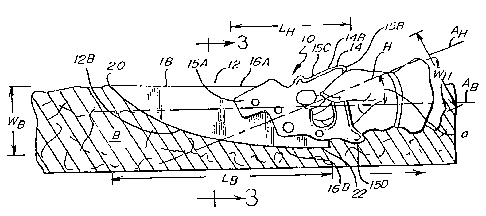Some of the information on this Web page has been provided by external sources. The Government of Canada is not responsible for the accuracy, reliability or currency of the information supplied by external sources. Users wishing to rely upon this information should consult directly with the source of the information. Content provided by external sources is not subject to official languages, privacy and accessibility requirements.
Any discrepancies in the text and image of the Claims and Abstract are due to differing posting times. Text of the Claims and Abstract are posted:
| (12) Patent: | (11) CA 2206905 |
|---|---|
| (54) English Title: | KNIFE FOR CUTTING INSULATION BATTS |
| (54) French Title: | COUTEAU POUR COUPER DES NATTES D'ISOLANT FIBREUX |
| Status: | Expired and beyond the Period of Reversal |
| (51) International Patent Classification (IPC): |
|
|---|---|
| (72) Inventors : |
|
| (73) Owners : |
|
| (71) Applicants : |
|
| (74) Agent: | BORDEN LADNER GERVAIS LLP |
| (74) Associate agent: | |
| (45) Issued: | 2001-07-31 |
| (22) Filed Date: | 1997-05-21 |
| (41) Open to Public Inspection: | 1997-11-30 |
| Examination requested: | 1997-08-18 |
| Availability of licence: | N/A |
| Dedicated to the Public: | N/A |
| (25) Language of filing: | English |
| Patent Cooperation Treaty (PCT): | No |
|---|
| (30) Application Priority Data: | ||||||
|---|---|---|---|---|---|---|
|
A knife for cutting fibrous insulation batts in a single motion with one hand
consists of a blade having a smooth, curved edge adapted to both compress and cut
the insulation batt along the entire length of the curved edge without tearing the
insulation batt and a handle permanently and non-movably attached to one end of the
blade.
Couteau pour couper d'une seule main et d'un seul trait des nattes d'isolant fibreux. Le couteau comporte une lame à bord tranchant incurvé permettant à la fois de comprimer et de couper la natte d'isolant sur toute la longueur du bord incurvé sans déchirer l'isolant. Le couteau comporte une poignée fixée en permanence à une de ses extrémités.
Note: Claims are shown in the official language in which they were submitted.
Note: Descriptions are shown in the official language in which they were submitted.

2024-08-01:As part of the Next Generation Patents (NGP) transition, the Canadian Patents Database (CPD) now contains a more detailed Event History, which replicates the Event Log of our new back-office solution.
Please note that "Inactive:" events refers to events no longer in use in our new back-office solution.
For a clearer understanding of the status of the application/patent presented on this page, the site Disclaimer , as well as the definitions for Patent , Event History , Maintenance Fee and Payment History should be consulted.
| Description | Date |
|---|---|
| Time Limit for Reversal Expired | 2016-05-24 |
| Letter Sent | 2015-05-21 |
| Inactive: Late MF processed | 2014-05-21 |
| Maintenance Request Received | 2014-05-21 |
| Letter Sent | 2013-05-21 |
| Appointment of Agent Requirements Determined Compliant | 2008-11-04 |
| Inactive: Office letter | 2008-11-04 |
| Inactive: Office letter | 2008-11-04 |
| Revocation of Agent Requirements Determined Compliant | 2008-11-04 |
| Letter Sent | 2008-11-03 |
| Appointment of Agent Request | 2008-08-25 |
| Inactive: Single transfer | 2008-08-25 |
| Revocation of Agent Request | 2008-08-25 |
| Inactive: Late MF processed | 2008-05-21 |
| Letter Sent | 2007-05-22 |
| Inactive: Office letter | 2007-02-21 |
| Inactive: Entity size changed | 2007-01-27 |
| Inactive: Corrective payment - s.78.6 Act | 2007-01-17 |
| Inactive: Late MF processed | 2005-09-30 |
| Letter Sent | 2005-05-24 |
| Grant by Issuance | 2001-07-31 |
| Inactive: Cover page published | 2001-07-30 |
| Pre-grant | 2001-05-01 |
| Inactive: Final fee received | 2001-05-01 |
| Notice of Allowance is Issued | 2000-11-03 |
| Notice of Allowance is Issued | 2000-11-03 |
| Letter Sent | 2000-11-03 |
| Inactive: Approved for allowance (AFA) | 2000-10-23 |
| Amendment Received - Voluntary Amendment | 2000-08-14 |
| Inactive: S.30(2) Rules - Examiner requisition | 2000-03-27 |
| Appointment of Agent Requirements Determined Compliant | 1999-06-15 |
| Inactive: Office letter | 1999-06-15 |
| Inactive: Office letter | 1999-06-15 |
| Revocation of Agent Requirements Determined Compliant | 1999-06-15 |
| Revocation of Agent Request | 1999-05-18 |
| Revocation of Agent Request | 1999-05-18 |
| Appointment of Agent Request | 1999-05-18 |
| Appointment of Agent Request | 1999-05-18 |
| Inactive: Adhoc Request Documented | 1998-02-18 |
| Letter Sent | 1998-02-18 |
| Application Published (Open to Public Inspection) | 1997-11-30 |
| Inactive: First IPC assigned | 1997-09-16 |
| Classification Modified | 1997-09-16 |
| Inactive: IPC assigned | 1997-09-16 |
| All Requirements for Examination Determined Compliant | 1997-08-18 |
| Request for Examination Requirements Determined Compliant | 1997-08-18 |
| All Requirements for Examination Determined Compliant | 1997-08-18 |
| All Requirements for Examination Determined Compliant | 1997-08-18 |
| Request for Examination Received | 1997-08-18 |
| Inactive: Filing certificate - No RFE (English) | 1997-08-14 |
| Filing Requirements Determined Compliant | 1997-08-14 |
| Application Received - Regular National | 1997-08-11 |
There is no abandonment history.
The last payment was received on 2001-05-01
Note : If the full payment has not been received on or before the date indicated, a further fee may be required which may be one of the following
Please refer to the CIPO Patent Fees web page to see all current fee amounts.
Note: Records showing the ownership history in alphabetical order.
| Current Owners on Record |
|---|
| RES-Q-JACK, INC. |
| Past Owners on Record |
|---|
| RICHARD L. STUDER |
| WILLIAM J. BECKERS |